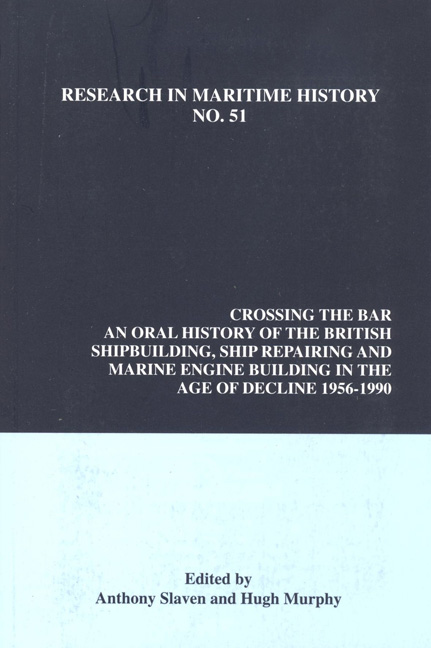 Crossing the Bar
Crossing the Bar Book contents
- Frontmatter
- Contents
- About the Authors
- Dedication
- Preface: A Shipbuilding Libretto
- Introduction
- Interviews
- Lower Clyde
- 1 Alexander Ross Belch, Lithgows, Scott Lithgow, British Shipbuilders Plc
- 2 Johnston Robb, Scotts Shipbuilding and Engineering, Scott Lithgow Ltd.
- 3 Willie Ferguson, William Hamilton and Sons, Lithgows, Scott Lithgow Ltd.
- Upper Clyde
- The Tyne
- The Wear
- Barrow-in-Furness
- The South Coast
- The Humber
- Belfast
- British Shipbuilding Industry Officials
- The Trade Unions
- The Civil Servants, Board of Trade, Shipbuilding Enquiry Committee, Shipbuilding Industry Board, Ministry of Technology, Department of Trade and Industry, Department of Industry
- The Politicians
- Interviews British Shipbuilders Plc
- Conclusion
- Select Bibliography
3 - Willie Ferguson, William Hamilton and Sons, Lithgows, Scott Lithgow Ltd.
from Lower Clyde
- Frontmatter
- Contents
- About the Authors
- Dedication
- Preface: A Shipbuilding Libretto
- Introduction
- Interviews
- Lower Clyde
- 1 Alexander Ross Belch, Lithgows, Scott Lithgow, British Shipbuilders Plc
- 2 Johnston Robb, Scotts Shipbuilding and Engineering, Scott Lithgow Ltd.
- 3 Willie Ferguson, William Hamilton and Sons, Lithgows, Scott Lithgow Ltd.
- Upper Clyde
- The Tyne
- The Wear
- Barrow-in-Furness
- The South Coast
- The Humber
- Belfast
- British Shipbuilding Industry Officials
- The Trade Unions
- The Civil Servants, Board of Trade, Shipbuilding Enquiry Committee, Shipbuilding Industry Board, Ministry of Technology, Department of Trade and Industry, Department of Industry
- The Politicians
- Interviews British Shipbuilders Plc
- Conclusion
- Select Bibliography
Summary
I began as an apprentice in the Drawing Office of William Hamilton and Company in Port Glasgow in 1949. After gaining a Higher National Certificate I began my national service in 1955, and then returned to William Hamilton and remained there until they merged with Lithgows in 1960/1. I then moved to the estimating and design departments of Lithgows until 1967, when I became Chief Designer, and in the early 1970s after the merger, I became technical manager, and in 1976, Technical Director. In 1980, I became Technical Director to the Board of Scott Lithgow, but left the firm to join British Shipbuilders after Scott Lithgow became the first British yard to be privatised by the then Conservative Government in March 1984, when it was controversially sold to Trafalgar House pic.
In Lithgows Limited, which I was familiar with from 1960-1969, I would say that the strengths of the company fell into major categories such as good leadership and communications, technical strength, good facilities and investment in those facilities. We had established production processes with well defined functional organisation in the company. We had a good relationship with owners, brokers and ship managers, which helped to provide continuity of work for the same range of ships with the same owners. We had good training facilities for our apprentices. Being a family company, the family spirit was engendered throughout the company structure. We had weaknesses which, within senior and junior management were recognised. There was no real employee relations policy. We did not have a high-powered personnel department. The employee relations were a bit paternalistic, and whenever there were problems there tended to be a buy-out of the problem. Someone would assess the value and decide that the best solution was to buy the guys off. There was a poor graduate intake into production areas. Most of the graduates who joined the company tended to find themselves in the technical department. Perhaps, because of the family atmosphere, people were slow to accept changes, particularly in respect of management style and production processes. That may have been because of the age profile of the management, but, at least in the technical department, there tended to a younger age profile.
- Type
- Chapter
- Information
- Crossing the BarAn Oral History of the British Shipbuilding, Ship Repairing and Marine Engine-Building Industries in the Age of Decline, 1956-1990, pp. 12 - 18Publisher: Liverpool University PressPrint publication year: 2013


